Physical Address
304 North Cardinal St.
Dorchester Center, MA 02124
Failure in the proper closure of part or all of the neural tube; called induction disorder (neural tube induced by the notochord and paraxial mesoderm during the third to fourth week of gestation)
Incidence 0.5 to 1.3 cases per 1000 live births
Male-to-female ratio—about 1 : 5
Cause of neural tube defects (NTDs): multifactorial (genetic, environmental, and nutritional)
Known environmental factors: folic acid deficiency, maternal diabetes, anticonvulsant medications, hyperthermia
Featured in several genetic syndromes: trisomy 13, trisomy 18, chromosome rearrangements, and deletions of 22q11
Range of symptomatology from in utero demise, coma, severe deficits including paraplegia; can be asymptomatic with spina bifida occulta
Early detection by screening for elevated maternal serum α-fetoprotein
Ultrasound for confirmation
Amniotic fluid α-fetoprotein and amniotic fluid acetylcholinesterase tests used in some cases
Depends on the specific type of defect and extent of nervous system injury
Anencephaly and craniospinal rachischisis are incompatible with life
Spinal defects may be associated with lower-extremity weakness, paralysis, bowel and bladder dysfunction
Meningitis is major complication of open neural tube defects
Folic acid (used in methylation and nucleic acid synthesis, deficiency leads to hyper-homocystinemia) administered during the periconceptional period—significantly reduces but does not eliminate risk
Genetic counseling—risk of recurrence of neural tube defect in those who have a first-degree relative is 5 to 10 times greater than the general population
Classification based on the part of the CNS involved (brain or spinal cord) and whether defect is open or closed (covered by overlying structures—meninges, bone, skin)
Open NTDs:
Anencephaly: (“without brain”) failure of brain formation with absent calvaria—skull base has formed; froglike facies with bulging eyes (ocular development begins before the critical period of neural tube closure, i.e., during the third to fourth week of gestation)
Craniospinal rachischisis : failure of closure of most or all of the neuraxis resulting in an absence/exposure of major portions of brain and spinal cord
Spina bifida cystica with myelomeningocele : herniation of the spinal cord and meninges through spinal defect
Spina bifida cystica with meningocele : herniation of the meninges, but not the cord
Encephalocele : usually included with NTDs; brain displaced through occipital or frontal defect
Iniencephaly : extreme bending of the head to the spine; neck usually absent
Closed NTDs (covered by skin):
Myelocystocele : terminal cystic dilatation of the cord resulting from hydromyelia
Lipomyelomeningocele : herniated conus medullaris infiltrated by fat
Lipomeningocele : meninges surrounded by a lipoma
Tethered cord : adhesions of spinal cord
Spina bifida occulta : bony defect in vertebral column; no herniation of CNS elements
Area cerebrovasculosa: poorly formed neurovascular tissue
Meningomyelocele consists of disorganized blood vessels, rudimentary neuroglial tissue, and sometimes peripheral nerves
Amniotic bands with craniocerebral destruction
Hydranencephaly—well-formed skull is usually present in this entity
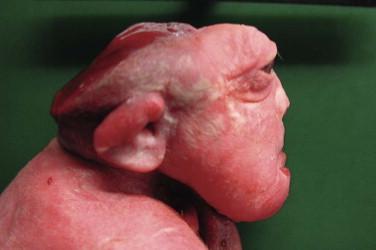

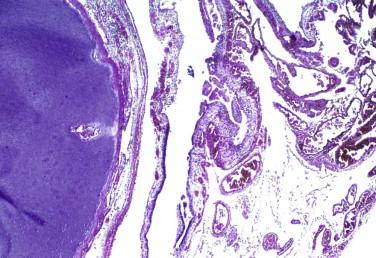
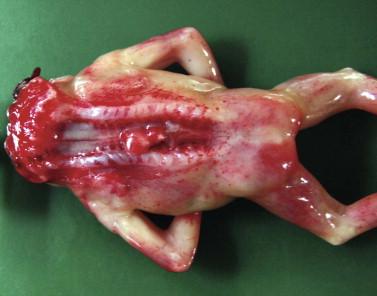
A spectrum of midline patterning defects that involve forebrain and midline facial structures; brain malformation results from failure of the prosencephalon to develop into two telencephalic vesicles
Incidence: 0.5 to 1 per 10,000 live births
1 per 250 spontaneous abortions
Affects males and females about equally
Chromosomal abnormalities in 25% to 50% of cases (see “Genetics,” discussed later)
Environmental risk factors: maternal diabetes, hypercholesterolemia, Smith-Lemli-Opitz syndrome (defects in cholesterol biosynthesis), various drugs including statins, alcoholism
Highly variable depending on the degree of brain malformation and facial defect
Least severe: arrhinencephaly (discussed later) with anosmia, single central incisor
Cleft lip or palate, hypotelorism, flat single-nostril nose/cebocephaly
Most severe: cyclopia with forehead/proboscis-like structure
Other findings: microcephaly, hydrocephalus
Depends on the type of HPE and associated anomalies
High incidence of fetal demise in most severe cases
Cognitive delay, mental retardation, epilepsy, endocrine abnormalities
Less severe cases have normal or near-normal brain development with mild facial anomalies
Genetic counseling in families with autosomal dominant forms
Alobar holoprosencephaly: complete failure in forebrain separation resulting in a single “holospheric” cerebrum
Semilobar holoprosencephaly: frontal and parietal lobes appear fused with posterior interhemispheric fissure
Lobar holoprosencephaly: only rostralmost areas of cerebral hemispheres show fusion
Syntelencephaly : “middle interhemispheric variant” of holoprosencephaly: the posterior frontal and parietal lobes are not properly separated but rostrobasal forebrain separation normal
Arrhinencephaly : malformation limited to absence of olfactory bulbs and tracts accompanied by absence of the gyri recti
Highly variable; disorganized cortical cytoarchitecture; heterotopias; disorganization of fused midline structures
Brain stem and cerebellum usually spared
Trisomy 13 (most common) and 18
Deletions or duplications in chromosome 13q
Numerous chromosomal regions implicated in holoprosencephaly: HPE 1-7, corresponding to numerous genes including sonic hedgehog ( SHH ), which maps to HPE3 on chromosome 7q36 and ZIC2 on chromosome 13, which corresponds to HPE5
Many other genes implicated or yet to be identified
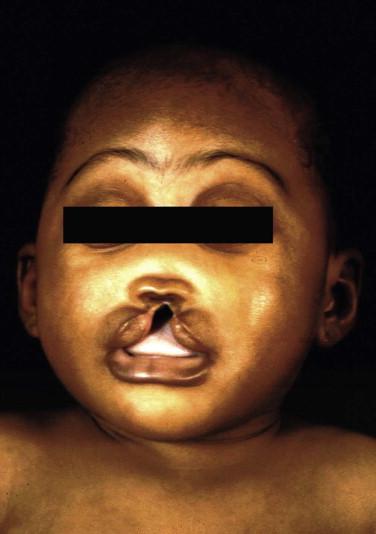
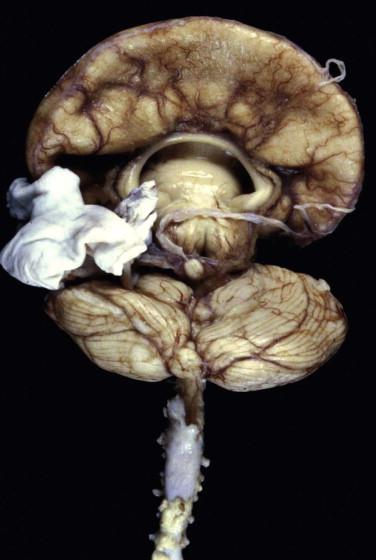
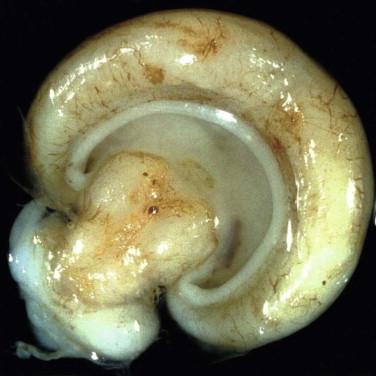
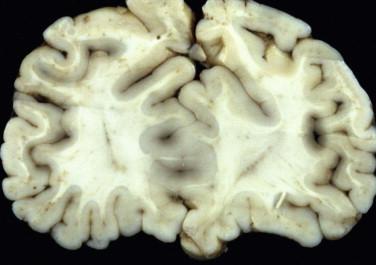
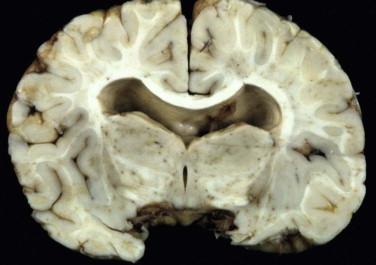
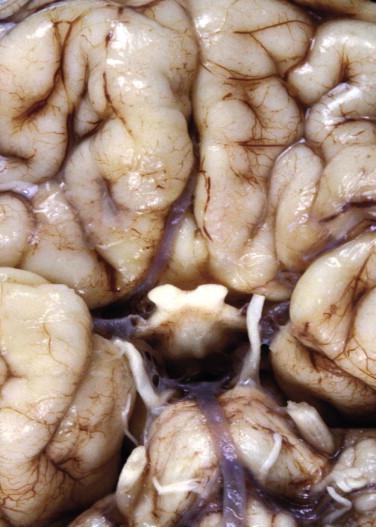
Become a Clinical Tree membership for Full access and enjoy Unlimited articles
If you are a member. Log in here